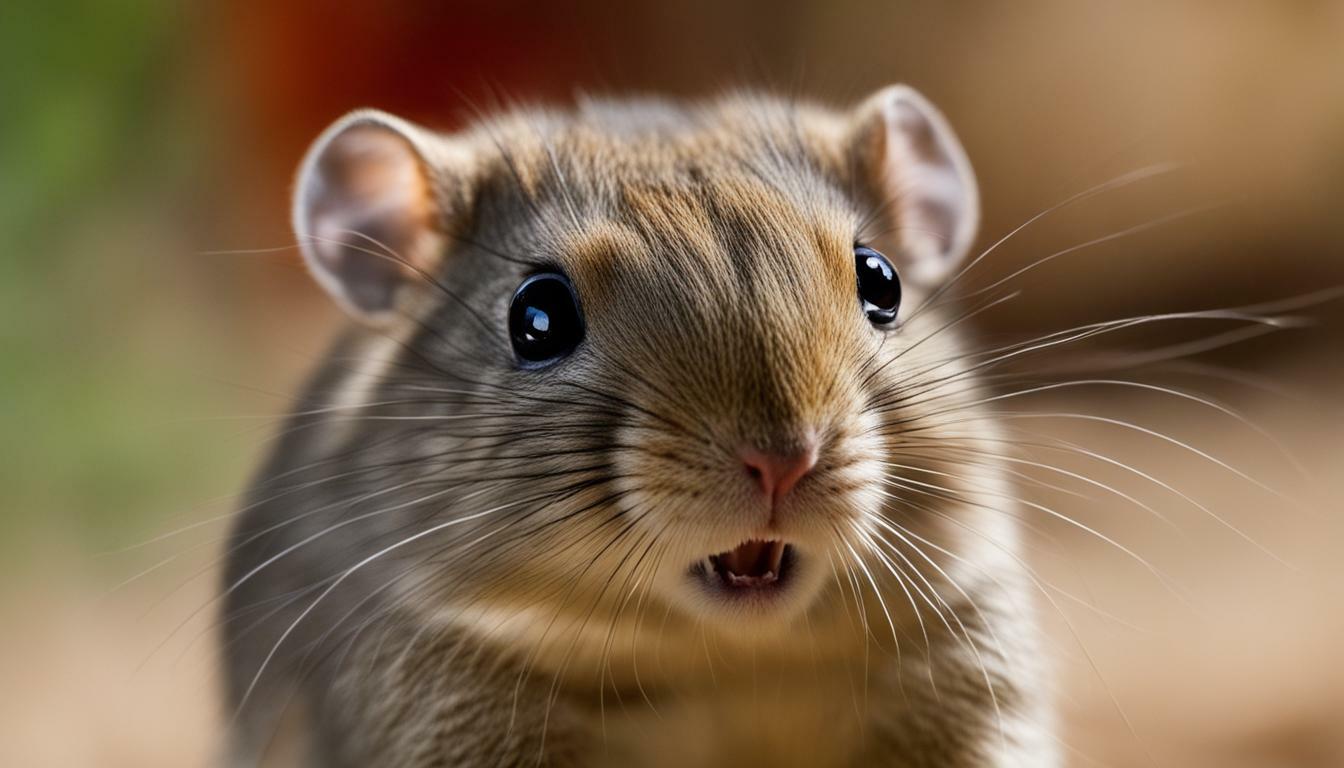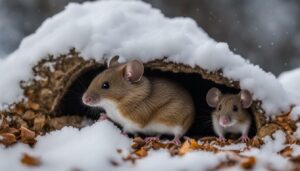Gerbils may exhibit aggressive behavior when they are in heat, particularly during the mating season.
Female gerbils can become aggressive, chasing and mounting other gerbils, including those of the same sex.
This behavior is a result of their heightened sexual drive during this time. It is crucial to closely monitor the gerbils to ensure the smaller ones are not being bullied or harmed.
Providing a larger enclosure or using a divider can help keep them safe. Female gerbils come into heat every four to six days, so this behavior may occur frequently.
It is advisable to consult a veterinarian for guidance on managing aggression during this period.
Key Takeaways:
- Female gerbils can become aggressive when in heat, chasing and mounting other gerbils.
- Increased sexual drive during the mating season is a cause of this aggressive behavior.
- Close monitoring is necessary to ensure the safety of smaller gerbils in the enclosure.
- Providing a larger enclosure or using a divider can help protect smaller gerbils from aggression.
- Consulting a veterinarian is recommended for guidance on managing aggression during the heat cycle.
Signs of Aggression in Gerbils
When gerbils are in heat, they may exhibit signs of aggression, which can include chasing, mounting, and territorial behavior.
This behavior is a result of their increased sexual drive during this time. It is important to monitor the gerbils closely to ensure that the smaller one is not being bullied or harmed.
If you notice that one gerbil is constantly chasing or mounting the other, it may be a sign of aggression. In some cases, the aggression may be directed towards gerbils of the same sex.
Gerbils can become territorial during heat, and they may show aggressive behavior towards both males and females in an attempt to establish dominance.
To ensure the safety of smaller gerbils, it may be necessary to provide a larger enclosure or use a divider to separate them from the more aggressive gerbil.
This will create a safe space for the smaller gerbil and prevent any potential harm. By implementing these measures, you can help maintain a harmonious environment for all gerbils involved.
| Signs of Aggression in Gerbils: |
|---|
| Chasing other gerbils |
| Mounting other gerbils |
| Territorial behavior |
Female gerbils come into heat every four to six days, so this behavior may occur frequently. If you are unsure how to handle aggressive behavior during this time, it is recommended to consult with a veterinarian.
They can provide guidance on managing the aggression and offer advice on creating a calming environment for all gerbils.
Understanding Gerbil Mating Season
The gerbil mating season is characterized by the frequency of female gerbils coming into heat every four to six days.
During this time, their sexual drive increases, leading to certain behaviors that may be perceived as aggressive.
It is important to closely monitor gerbils during their heat cycle to ensure the safety of all gerbils involved, especially smaller ones who may be bullied or harmed.
To provide a safe environment for gerbils during mating season, it may be necessary to consider the size of the enclosure.
Providing a larger enclosure or using a divider can help prevent aggression and keep gerbils separated when needed.
By creating separate spaces, gerbils can still interact visually and audibly without the risk of physical harm.
Consulting a veterinarian is essential when dealing with aggressive gerbils during their heat cycle. Veterinarians possess the knowledge and expertise to provide guidance on managing this behavior and maintaining the overall well-being of the gerbils.
They can offer specific advice tailored to the individual gerbil’s needs, ensuring a safe and harmonious environment.
| Key Points | Benefits |
|---|---|
| Monitor gerbils closely during their heat cycle | Prevent bullying and harm |
| Consider size of the enclosure | Create a safe environment |
| Consult a veterinarian | Receive expert guidance |
Conclusion
The gerbil mating season is characterized by increased sexual drive and the frequency of females coming into heat every four to six days.
Aggressive behavior may be observed during this time, especially in smaller gerbils who may be vulnerable to bullying.
By closely monitoring the gerbils, providing a suitable enclosure, and seeking guidance from a veterinarian, you can ensure a safe and harmonious environment for all gerbils involved.
Handling Aggressive Gerbils
It is important to know how to handle aggressive gerbils during their heat cycle to ensure the well-being of all gerbils in the enclosure.
Female gerbils can become aggressive when they are in heat due to their heightened sexual drive. This behavior is characterized by chasing and mounting other gerbils, including those of the same sex.
To prevent potential harm or bullying, close monitoring of the gerbils is crucial.
If you notice aggressive behavior, it may be necessary to provide a larger enclosure or use a divider to separate the gerbils.
This will help create a safe space for both the aggressive gerbil and the smaller, potentially targeted gerbil. By giving them their own areas, you can minimize the risk of injury or stress.
Additionally, creating separate play and feeding zones within the enclosure can further reduce tensions during the heat cycle.
Female gerbils enter heat every four to six days, meaning this aggressive behavior may occur frequently. To ensure the best care for your gerbils, it is highly recommended to consult a veterinarian.
They can provide expert guidance on managing aggression during this period and offer specific tips tailored to your gerbils’ needs.
A veterinarian will take into consideration individual factors such as age, breed, and overall health when advising you on how to calm the gerbils and create a more harmonious environment.
| Tips for Handling Aggressive Gerbils During Heat: |
|---|
| 1. Monitor gerbils closely to identify aggressive behavior. |
| 2. Provide a larger enclosure or use a divider to separate gerbils if necessary. |
| 3. Create separate play and feeding zones to reduce tensions. |
| 4. Consult a veterinarian for expert guidance on managing aggression. |
| 5. Follow veterinarian’s advice on calming techniques specific to your gerbils. |
Ensuring the Safety of Smaller Gerbils
When aggression arises during the gerbil heat cycle, it is essential to closely monitor the behavior to ensure the safety of smaller gerbils.
Female gerbils can become aggressive during this period, displaying chasing and mounting behaviors towards other gerbils, including those of the same sex.
This behavior is a result of their increased sexual drive.
To protect smaller gerbils from potential harm, it may be necessary to provide a larger enclosure or use a divider to create separate areas.
This will help minimize the chances of aggression and ensure a safe environment for all gerbils involved. By creating physical boundaries, you can reduce the risk of injury and stress to the smaller gerbils.
It is important to note that female gerbils come into heat every four to six days, meaning this aggressive behavior may occur frequently.
Regular monitoring of their interactions is crucial to identify any signs of bullying or harm towards the smaller gerbils.
| Recommendations for Ensuring Safety | Benefits |
|---|---|
| Provide a larger enclosure | Allows for more space and can help reduce territorial disputes |
| Use a divider | Creates separate areas, preventing direct contact between gerbils |
| Regular monitoring | Enables early detection of aggressive behavior and intervention if necessary |
To ensure the well-being of all gerbils, consulting a veterinarian is recommended. They can provide expert guidance on how to handle aggressive behavior during the gerbil heat cycle.
Veterinarians can offer personalized advice based on the specific needs and dynamics of your gerbil colony, helping you create a safe and harmonious environment for all gerbils involved.
Consulting a Veterinarian
Consulting a veterinarian is crucial when it comes to dealing with aggressive gerbils during their heat cycle, especially during the breeding season.
Female gerbils can exhibit heightened aggression when they are in heat, which may result in chasing and mounting behavior towards other gerbils, even those of the same sex.
These actions are driven by their increased sexual drive during this time.
It is important to closely monitor the gerbils to ensure the smaller ones are not being bullied or harmed. If aggression becomes a concern, providing a larger enclosure or using a divider may be necessary to create a safe environment for all gerbils involved.
This will give the smaller gerbils a chance to retreat and avoid any potential harm.
Female gerbils typically come into heat every four to six days, meaning this behavior may occur frequently during the breeding season.
Therefore, it is essential to seek guidance from a veterinarian who specializes in small animal care. They can provide valuable insights and advice on how to handle aggressive behavior during this time, ensuring the well-being of your gerbils.
| Key takeaways: |
|---|
| 1. Female gerbils can become aggressive during their heat cycle, especially during the breeding season. |
| 2. Monitor the gerbils closely to prevent bullying or harm, particularly to smaller gerbils. |
| 3. Consulting a veterinarian who specializes in small animal care is recommended to handle aggressive behavior effectively. |
Creating a Calming Environment
Creating a calming environment for gerbils in heat can help minimize aggression and provide a more comfortable experience for them. Female gerbils can become aggressive when they are in heat due to their increased sexual drive. If you notice signs of aggression, it is important to monitor the gerbils closely, especially if you have smaller gerbils in the same enclosure.
To ensure the safety of smaller gerbils, consider providing a larger enclosure or using a divider to separate them during the heat cycle. This will help prevent any bullying or harm that may occur. Female gerbils come into heat every four to six days, so it is important to be prepared for this behavior to occur frequently.
If you are unsure how to handle aggressive behavior during the heat cycle, it is recommended to consult a veterinarian. They can provide guidance on managing aggression and offer valuable advice on creating a safe and calm environment for your gerbils. Remember to always prioritize the well-being and safety of your gerbils by observing their behavior and providing appropriate care and attention.
The Role of Hormones in Aggressive Behavior
Hormones play a crucial role in gerbil behavior during their heat cycle, including the manifestation of aggressive behaviors. Female gerbils experience an increase in hormones, such as estrogen and progesterone, which can lead to heightened sexual drive and territoriality. This surge in hormones can cause them to become more aggressive towards other gerbils, even those of the same sex.
During this time, female gerbils may exhibit behaviors such as chasing, mounting, and even biting. It is important to closely monitor the gerbils, particularly if there is a size difference between individuals. The smaller gerbil may be at risk of being bullied or harmed by the more aggressive one. To ensure their safety, it may be necessary to provide a larger enclosure or use a divider to separate them.
Female gerbils typically come into heat every four to six days, so aggressive behavior may occur frequently during their reproductive cycle. If you are unsure how to handle this aggression, it is recommended to consult a veterinarian. They can provide valuable guidance and advice on managing the behavior and ensuring the well-being of your gerbils during their heat cycle.
| Key Points: |
|---|
| Hormones play a crucial role in aggressive behavior during the gerbil heat cycle. |
| Female gerbils may become more aggressive towards other gerbils, including those of the same sex, during their heat cycle. |
| Closely monitor gerbils, especially if there is a size difference between individuals, to ensure the smaller one is not being harmed. |
| Consult a veterinarian for guidance on managing aggressive behavior during the heat cycle. |
Handling Aggression in Same-Sex Gerbil Pairs
Aggressive behavior can also occur in same-sex gerbil pairs during their heat cycle, and it is important to handle this behavior appropriately.
Female gerbils in heat may exhibit aggression towards their cage mates, regardless of gender. Signs of aggression include chasing, mounting, and aggressive vocalizations.
It is essential to closely observe and monitor the gerbils to ensure the safety and well-being of all individuals involved.
To handle aggression in same-sex gerbil pairs, there are several strategies that can be employed. Firstly, providing a larger enclosure or using a divider can help separate the gerbils and reduce the likelihood of physical confrontations.
This can create a safer environment for both gerbils and prevent any potential harm or injuries.
Additionally, offering separate hiding spots and resources, such as food and water dishes, can help mitigate any competition and reduce aggression.
Regularly interacting and socializing with your gerbils can also help establish a sense of trust and familiarity.
Spending time with each gerbil individually and providing equal attention can promote a harmonious relationship between them.
It is important to remember that gerbil behavior can be influenced by various factors, including their individual personalities, so each pair may require a tailored approach.
| Handling Aggression in Same-Sex Gerbil Pairs |
|---|
| Observe and monitor gerbils closely |
| Provide a larger enclosure or use a divider |
| Offer separate hiding spots and resources |
| Regularly interact and socialize with gerbils |
If the aggression persists or escalates despite these measures, it is advisable to consult a veterinarian for further guidance. They can provide professional advice and potential solutions tailored to your specific gerbil pair. Remember, handling aggression in same-sex gerbil pairs during their heat cycle requires patience, observation, and proactive intervention to ensure a peaceful coexistence.
The Importance of Observation and Interaction
Observing and interacting with gerbils during their heat cycle is crucial to gain insights into their behavior and ensure their well-being. Female gerbils can become aggressive during this time, displaying behaviors such as chasing and mounting other gerbils, even those of the same sex. This aggression is a result of their heightened sexual drive. By closely monitoring their interactions, you can ensure that smaller gerbils are not being bullied or harmed by their more aggressive counterparts.
To create a safe environment for all gerbils involved, consider providing a larger enclosure or using a divider to separate them. This will help to reduce the risk of any physical harm and allow each gerbil to have their own space when needed.
It’s important to note that female gerbils come into heat every four to six days, so this behavior may occur frequently. By consulting a veterinarian, you can receive expert guidance on how to handle and manage aggressive behavior during this time. They can provide you with specific strategies to help calm gerbils in heat and create a more harmonious environment for your furry companions.
| Key Points |
|---|
| Observing and interacting with gerbils during their heat cycle is crucial. |
| Female gerbils can become aggressive, so monitoring their behavior is essential. |
| Providing a larger enclosure or using a divider can help keep gerbils safe. |
| Consulting a veterinarian for guidance is recommended. |
By taking these precautions and actively engaging with your gerbils, you can better understand their behavior during their heat cycle and provide them with a safe and nurturing environment. Remember, observing and interacting with your gerbils is the key to maintaining their well-being and ensuring a healthy and happy life for them.
Conclusion
In conclusion, gerbils can display aggressive behavior when in heat, and understanding their mating cycle is essential to provide appropriate care and ensure a harmonious gerbil community.
Female gerbils can become aggressive during their heat cycle, which is characterized by increased sexual drive. They may chase and mount other gerbils, including those of the same sex. It is crucial to closely monitor gerbils during this time to ensure that the smaller ones are not being bullied or harmed.
To keep smaller gerbils safe, it may be necessary to provide a larger enclosure or use a divider. This helps to create separate spaces and prevent any potential harm or stress caused by aggression. Additionally, it is important to note that female gerbils come into heat every four to six days, so this behavior may occur frequently.
When dealing with aggressive gerbils during their heat cycle, it is highly recommended to consult a veterinarian. They can provide guidance on handling this behavior and offer valuable advice on creating a calming environment. By seeking professional assistance, you can ensure the well-being of your gerbils and maintain a peaceful and enjoyable gerbil community.
FAQ
Are female gerbils aggressive when in heat?
Yes, female gerbils can become aggressive when in heat. They may chase and mount other gerbils, even those of the same sex. This behavior is a result of their increased sexual drive during this time.
What should I do if I notice aggression in my gerbils during their heat cycle?
It is important to monitor the gerbils closely to ensure that the smaller one is not being bullied or harmed. Providing a larger enclosure or using a divider may be necessary to keep them safe. Additionally, consulting a veterinarian for guidance on how to handle aggressive behavior during heat is recommended.
How often do female gerbils come into heat?
Female gerbils come into heat every four to six days. This means that aggressive behavior may occur frequently during their heat cycle.
What are the signs of aggression in gerbils?
Signs of aggression in gerbils during their heat cycle may include chasing, mounting, and aggressive vocalizations. It is important to observe their behavior closely to identify these signs.
How can I calm down aggressive gerbils in heat?
Creating a calming environment for gerbils in heat is essential. This can be achieved by reducing noise and disturbances in their surroundings, providing hiding spots, and ensuring that they have plenty of enrichment and stimulation.
How can I ensure the safety of smaller gerbils during aggressive behavior?
It is crucial to monitor the behavior of smaller gerbils when aggression occurs during the heat cycle. Providing a larger enclosure or using a divider can help keep them safe from bullying or harm.
When should I consult a veterinarian about aggressive gerbil behavior during their heat cycle?
It is recommended to consult a veterinarian if you are unsure how to handle aggressive gerbils during their heat cycle or if the behavior persists and becomes a concern. A veterinarian can offer guidance and expertise in managing this behavior.




